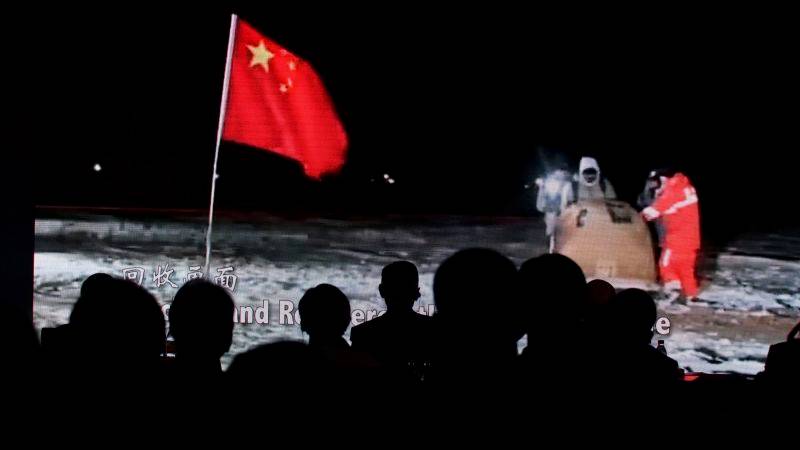(CNN) — China’s lunar mission to return the first samples ever collected from the far side of the moon is scheduled to take place next year, officials said, as Beijing ramps up its ambitious plan to send astronauts to the moon this decade and build an international research station.
Preparations for the next planned mission, known as Chang’e-6, are progressing smoothly, the China National Space Administration (CNSA) said in a statement last week, adding that the companion satellite will be deployed in the first half of next year. .
This week, the China National Space Administration is also eyeing its Chang’e-8 mission scheduled for 2028, and Chinese officials on Monday called for greater global cooperation for the unmanned lunar mission during the International Astronautical Congress in Baku, Azerbaijan.
In 2028, the Chinese mission will welcome “mission-level” joint projects with other countries and international organizations, according to a new report. document The attachment is published on the CNSA website.
This means that China and its international partners can work together to launch spacecraft and operate in orbit, conduct “interactions” between spacecraft and jointly explore the lunar surface, according to the document.
The spacecraft will also provide room for 200 kilograms of foreign scientific payloads, the agency said on its website. Chinese state media said this could allow foreign partners conducting lunar research to “benefit” from the mission.
China hopes that the upcoming missions, Chang’e-7 scheduled for 2026, will produce valuable data for building a permanent international research station at the moon’s south pole by 2040, as part of Beijing’s broader push to become a major power in space.
These efforts made China the first country to send a rover to the far side of the moon in 2019, completed construction of the Tiangong orbital space station last year, and announced plans to become the second country to land a manned mission on the moon. 2030.
Expanding Beijing’s international ties through space cooperation is also part of this plan, although so far only a few countries have been reported to have joined the planned lunar research station. Among them are Russia, Venezuela and South Africa, according to Chinese state media.
China is not alone in raising its space program and lunar ambitions, with many countries seeing the potential scientific benefits, national prestige, access to resources and further deep space exploration that successful lunar missions can bring.
Last month, India landed its Chandrayaan 3 spacecraft on the moon, becoming only the fourth country to achieve this feat, and its lunar landing was closer to the lunar south pole than any other spacecraft in history.
In the same week, the first Russian mission to the moon in decades ended in failure when the Luna 25 spacecraft collided with the lunar surface.
The United States has also strengthened its lunar program: it launched the first test flight in 2022 under its Artemis program, which aims to return American astronauts to the moon in 2025 and build a scientific base camp there, and NASA also has its sights set on the lunar South Pole. .
Like China, the United States is also mobilizing international partners, with more than two dozen countries having signed the Artemis Accords standards for “peaceful deep space exploration.” China is not among the current signatories.
China’s upcoming missions to the moon
The Chinese Space Agency said in a statement on Friday, in conjunction with the Mid-Autumn Festival, that the Chang’e-6 mission, which will be launched in Beijing next year, will work to deepen understanding of the far side of the Moon, as it will collect samples after 10 previous missions to the near side facing Earth. A Chinese national holiday associated with the moon.
“These samples will allow scientists to enhance their studies on the far side and analyze the composition of the samples to expand knowledge about the moon,” Hu Hao, a senior official working on the Chang’e 6 mission, told Chinese state media. week.
He said that the spacecraft is scheduled to land in the Aitken Basin in Antarctica on the other side to collect samples of dust and rocks there, referring to an important lunar landform of great scientific interest.
The far side of the Moon, which cannot be seen from Earth, is covered in craters, but unlike the near side, it is not dominated by large lunar mare or dark traces of ancient lava flows, a difference that puzzles scientists.
According to the China National Space Administration, the Chang’e-6 spacecraft will also carry payloads and satellites from four international partners.
These include a French radon detector, a negative ion detector from the European Space Agency, an Italian corner laser reflector for calibrating radar systems, and Pakistan’s CubeSat, a miniature square-shaped satellite.
The mission is expected to be followed by Chang’e-7 in 2026, which aims to search for lunar resources at the moon’s south pole, and Chang’e-8 two years later, which could study how lunar materials are used, officials said. . .
China has launched five robotic probes since 2007. Its last mission, Chang’e-5, landed on the moon in December 2020 and returned with samples of lunar rocks and soil.

“Proud web fanatic. Subtly charming twitter geek. Reader. Internet trailblazer. Music buff.”

:quality(85)/cloudfront-us-east-1.images.arcpublishing.com/infobae/TEQF6EONZRFGLLLDIDD4L2O4EE.jpg)

:quality(75)/cloudfront-us-east-1.images.arcpublishing.com/elcomercio/XU32LRAEZFDDPNVHLFU3CKVBYY.jpg)



More Stories
How to create 3D videos with my iPhone, it will be very useful even for your business
NASA discovers an anomaly in the Earth’s magnetic field that could have serious consequences for humans
Can the Earth be divided into two parts?